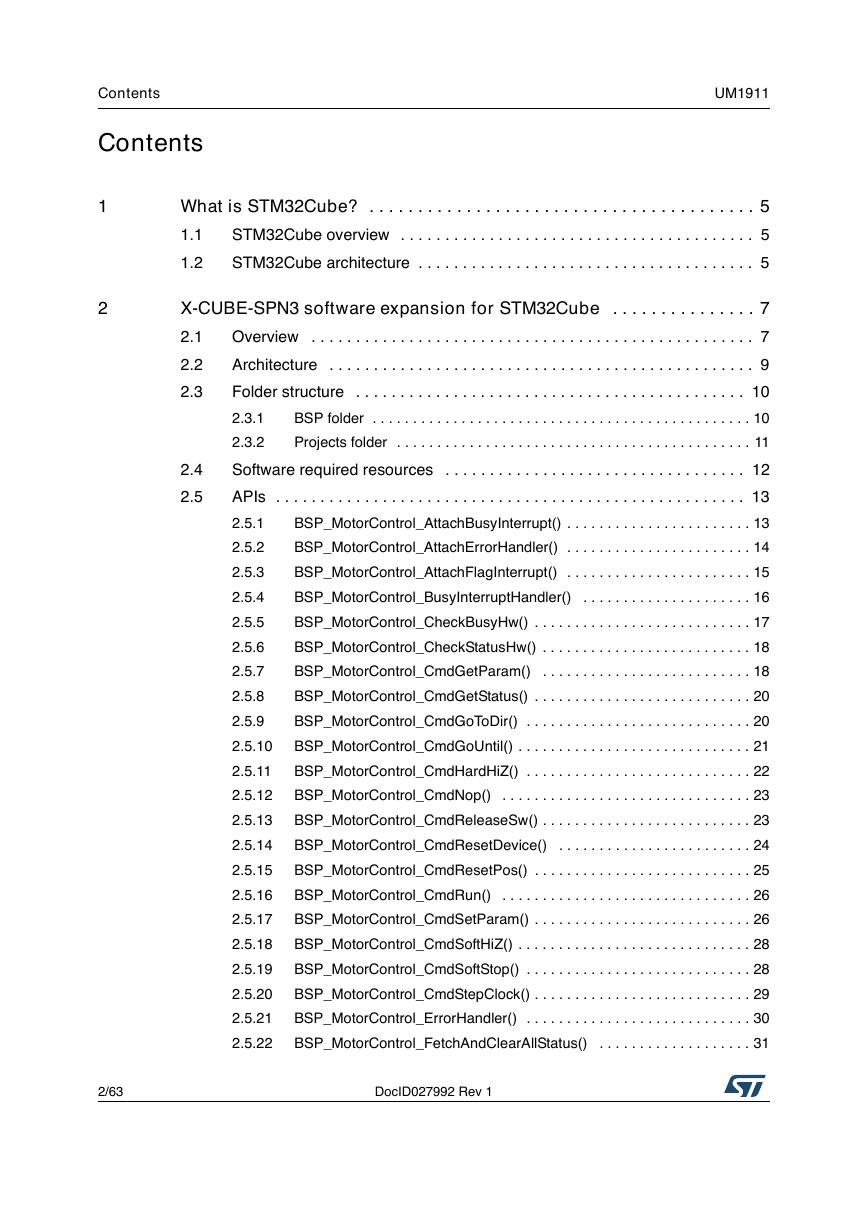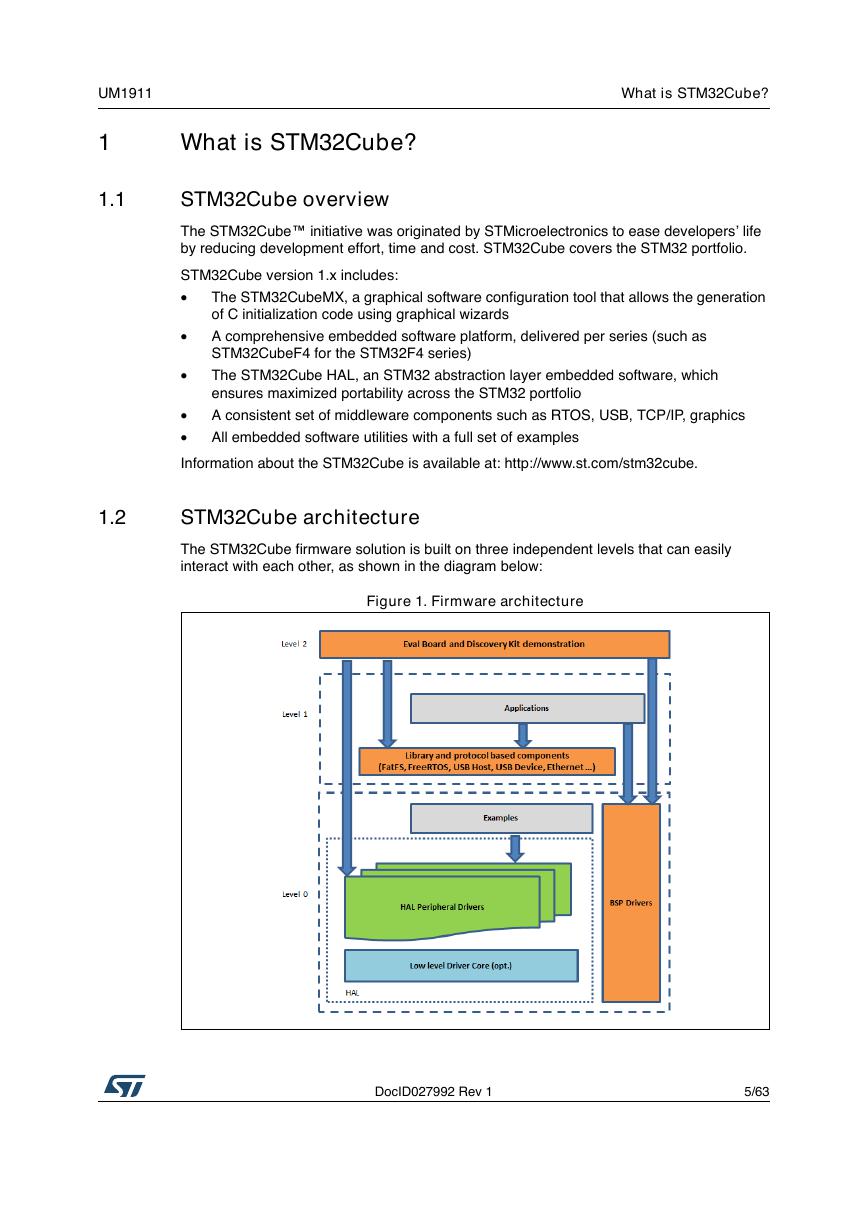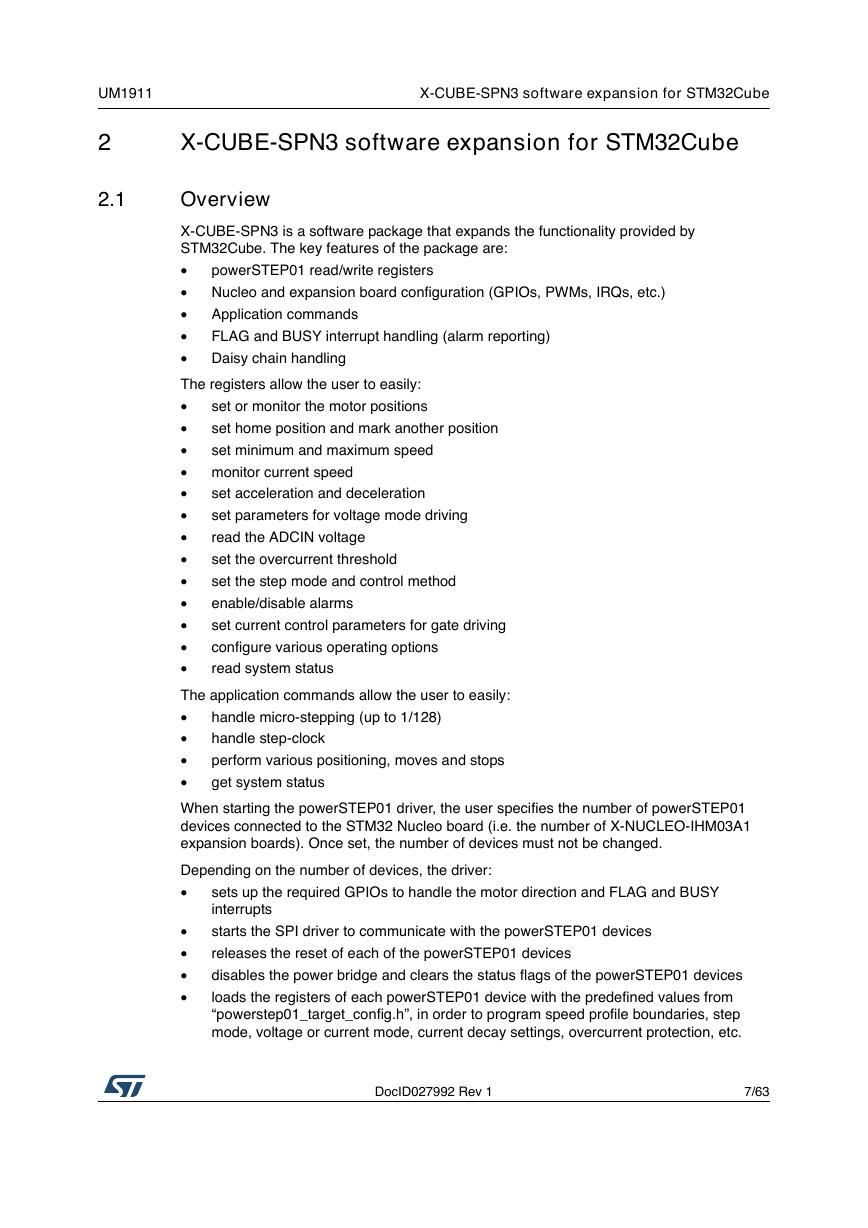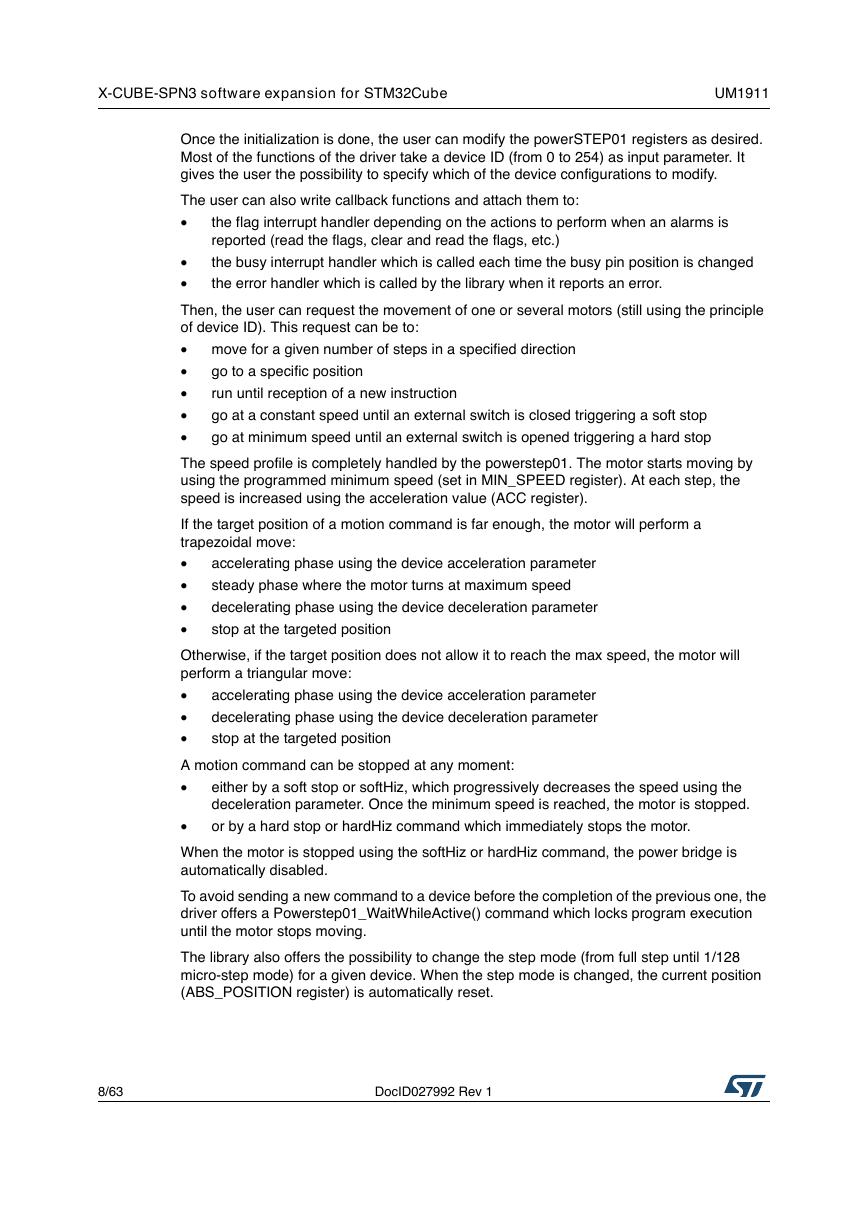Heading1 - 1 What is STM32Cube?
Heading2 - 1.1 STM32Cube overview
Heading2 - 1.2 STM32Cube architecture
Heading1 - 2 X-CUBE-SPN3 software expansion for STM32Cube
Heading2 - 2.1 Overview
Heading2 - 2.2 Architecture
Heading2 - 2.3 Folder structure
Heading3 - 2.3.1 BSP folder
Heading3 - 2.3.2 Projects folder
Heading2 - 2.4 Software required resources
Heading2 - 2.5 APIs
Heading3 - 2.5.1 BSP_MotorControl_AttachBusyInterrupt()
Heading3 - 2.5.2 BSP_MotorControl_AttachErrorHandler()
Heading3 - 2.5.3 BSP_MotorControl_AttachFlagInterrupt()
Heading3 - 2.5.4 BSP_MotorControl_BusyInterruptHandler()
Heading3 - 2.5.5 BSP_MotorControl_CheckBusyHw()
Heading3 - 2.5.6 BSP_MotorControl_CheckStatusHw()
Heading3 - 2.5.7 BSP_MotorControl_CmdGetParam()
Heading3 - 2.5.8 BSP_MotorControl_CmdGetStatus()
Heading3 - 2.5.9 BSP_MotorControl_CmdGoToDir()
Heading3 - 2.5.10 BSP_MotorControl_CmdGoUntil()
Heading3 - 2.5.11 BSP_MotorControl_CmdHardHiZ()
Heading3 - 2.5.12 BSP_MotorControl_CmdNop()
Heading3 - 2.5.13 BSP_MotorControl_CmdReleaseSw()
Heading3 - 2.5.14 BSP_MotorControl_CmdResetDevice()
Heading3 - 2.5.15 BSP_MotorControl_CmdResetPos()
Heading3 - 2.5.16 BSP_MotorControl_CmdRun()
Heading3 - 2.5.17 BSP_MotorControl_CmdSetParam()
Heading3 - 2.5.18 BSP_MotorControl_CmdSoftHiZ()
Heading3 - 2.5.19 BSP_MotorControl_CmdSoftStop()
Heading3 - 2.5.20 BSP_MotorControl_CmdStepClock()
Heading3 - 2.5.21 BSP_MotorControl_ErrorHandler()
Heading3 - 2.5.22 BSP_MotorControl_FetchAndClearAllStatus()
Heading3 - 2.5.23 BSP_MotorControl_FlagInterruptHandler()
Heading3 - 2.5.24 BSP_MotorControl_GetBoardId()
Heading3 - 2.5.25 BSP_MotorControl_GetFetchedStatus()
Heading3 - 2.5.26 BSP_MotorControl_GetFwVersion()
Heading3 - 2.5.27 BSP_MotorControl_GetMark()
Heading3 - 2.5.28 BSP_MotorControl_GetNbDevices()
Heading3 - 2.5.29 BSP_MotorControl_GetPosition()
Heading3 - 2.5.30 BSP_MotorControl_GoHome()
Heading3 - 2.5.31 BSP_MotorControl_GoMark()
Heading3 - 2.5.32 BSP_MotorControl_GoTo()
Heading3 - 2.5.33 BSP_MotorControl_HardStop()
Heading3 - 2.5.34 BSP_MotorControl_Init()
Heading3 - 2.5.35 BSP_MotorControl_IsDeviceBusy()
Heading3 - 2.5.36 BSP_MotorControl_Move()
Heading3 - 2.5.37 BSP_MotorControl_QueueCommands()
Heading3 - 2.5.38 BSP_MotorControl_ReleaseReset()
Heading3 - 2.5.39 BSP_MotorControl_Reset()
Heading3 - 2.5.40 BSP_MotorControl_SelectStepMode()
Heading3 - 2.5.41 BSP_MotorControl_SendQueuedCommands()
Heading3 - 2.5.42 BSP_MotorControl_SetHome()
Heading3 - 2.5.43 BSP_MotorControl_SetMark()
Heading3 - 2.5.44 BSP_MotorControl_StartStepClock()
Heading3 - 2.5.45 BSP_MotorControl_StopStepClock()
Heading3 - 2.5.46 BSP_MotorControl_WaitForAllDevicesNotBusy()
Heading3 - 2.5.47 BSP_MotorControl_WaitWhileActive()
Heading2 - 2.6 Sample application description
Heading1 - 3 System setup guide
Heading2 - 3.1 Hardware description
Heading3 - 3.1.1 STM32 Nucleo platform
Heading3 - 3.1.2 X-NUCLEO-IHM03A1 expansion board
Heading3 - 3.1.3 Miscellaneous HW components
Heading2 - 3.2 Software description
Heading2 - 3.3 Hardware and software setup
Heading3 - 3.3.1 Common setup to drive 1, 2 or 3 motors
Heading3 - 3.3.2 Setup to drive 1 motor
Heading3 - 3.3.3 Setup to drive 2 motors
Heading3 - 3.3.4 Setup to drive 3 motors
Heading1 - 4 Acronyms and abbreviations
Heading1 - 5 Revision history
















 V2版本原理图(Capacitive-Fingerprint-Reader-Schematic_V2).pdf
V2版本原理图(Capacitive-Fingerprint-Reader-Schematic_V2).pdf 摄像头工作原理.doc
摄像头工作原理.doc VL53L0X简要说明(En.FLVL53L00216).pdf
VL53L0X简要说明(En.FLVL53L00216).pdf 原理图(DVK720-Schematic).pdf
原理图(DVK720-Schematic).pdf 原理图(Pico-Clock-Green-Schdoc).pdf
原理图(Pico-Clock-Green-Schdoc).pdf 原理图(RS485-CAN-HAT-B-schematic).pdf
原理图(RS485-CAN-HAT-B-schematic).pdf File:SIM7500_SIM7600_SIM7800 Series_SSL_Application Note_V2.00.pdf
File:SIM7500_SIM7600_SIM7800 Series_SSL_Application Note_V2.00.pdf ADS1263(Ads1262).pdf
ADS1263(Ads1262).pdf 原理图(Open429Z-D-Schematic).pdf
原理图(Open429Z-D-Schematic).pdf 用户手册(Capacitive_Fingerprint_Reader_User_Manual_CN).pdf
用户手册(Capacitive_Fingerprint_Reader_User_Manual_CN).pdf CY7C68013A(英文版)(CY7C68013A).pdf
CY7C68013A(英文版)(CY7C68013A).pdf TechnicalReference_Dem.pdf
TechnicalReference_Dem.pdf